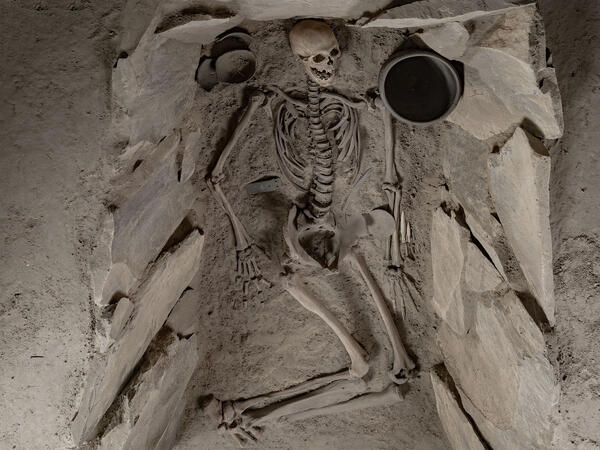This is a reconstructed burial of a Tagar man who lived in the Early Iron Age, about 8000 years ago. The Tagar archaeological culture is named after Tagar Island on the Yenisey River. The Tagar people were of the Caucasoid type, but had Mongoloid features. They lived in the Minusinsk Hollow — today it is a region of Krasnoyarsk Krai and the Republic of Khakassia. In the process of cultural development and population growth, the Tagars settled in the northern territories: the Chulym valley, the Mariinsk, Achinsk, Krasnoyarsk and Kansk forest-steppes.
The main occupation of the Tagar people was cattle breeding, with farming, gathering and fishing playing subsidiary roles. The Tagars were excellent metallurgists, skilled in the processing of non-ferrous metals. They were skilled in the art of war. There are preserved Tagar combat daggers, celt axes and pickaxes, which were used for close hand-to-hand combat, as well as arrowheads for long-range combat.
The Tagar and Scythian cultures have much in common. The bronze items of the Tagar people are made in the common Scythian-Siberian animal style, which is characterized by images of a deer, horse, bear, lizard, as well as a man with an animal head or bird wings.
The Tagar society was stratified, which is especially clear in the burial rites. Large and complex burial mounds were erected for persons of high social rank. More than a thousand Tagar burial mounds have been excavated, so their characteristics are well studied.
Tagar burial mounds are pits dug in the ground — square for one body and rectangular for several. Massive stone slabs — “stone boxes” — were placed along the walls and in the corners of the pit. The walls were sometimes covered with larch logs, which formed a log cabin with one or more rows of logs.
The deceased was laid at the bottom of the grave,
head to the west or southwest, with arms along the body. The Tagar provided all
the dead with household items, which, according to their beliefs, could be
useful in the afterlife. The sets of grave goods for men and women were
different. Women’s graves were more likely to contain jewelry: beads, plaques,
and pendants; men’s graves contained weapons: daggers, battle axes, axes, pole
axes, and arrowheads. The only common thing was the food stash, prepared for
the last journey of the deceased.



